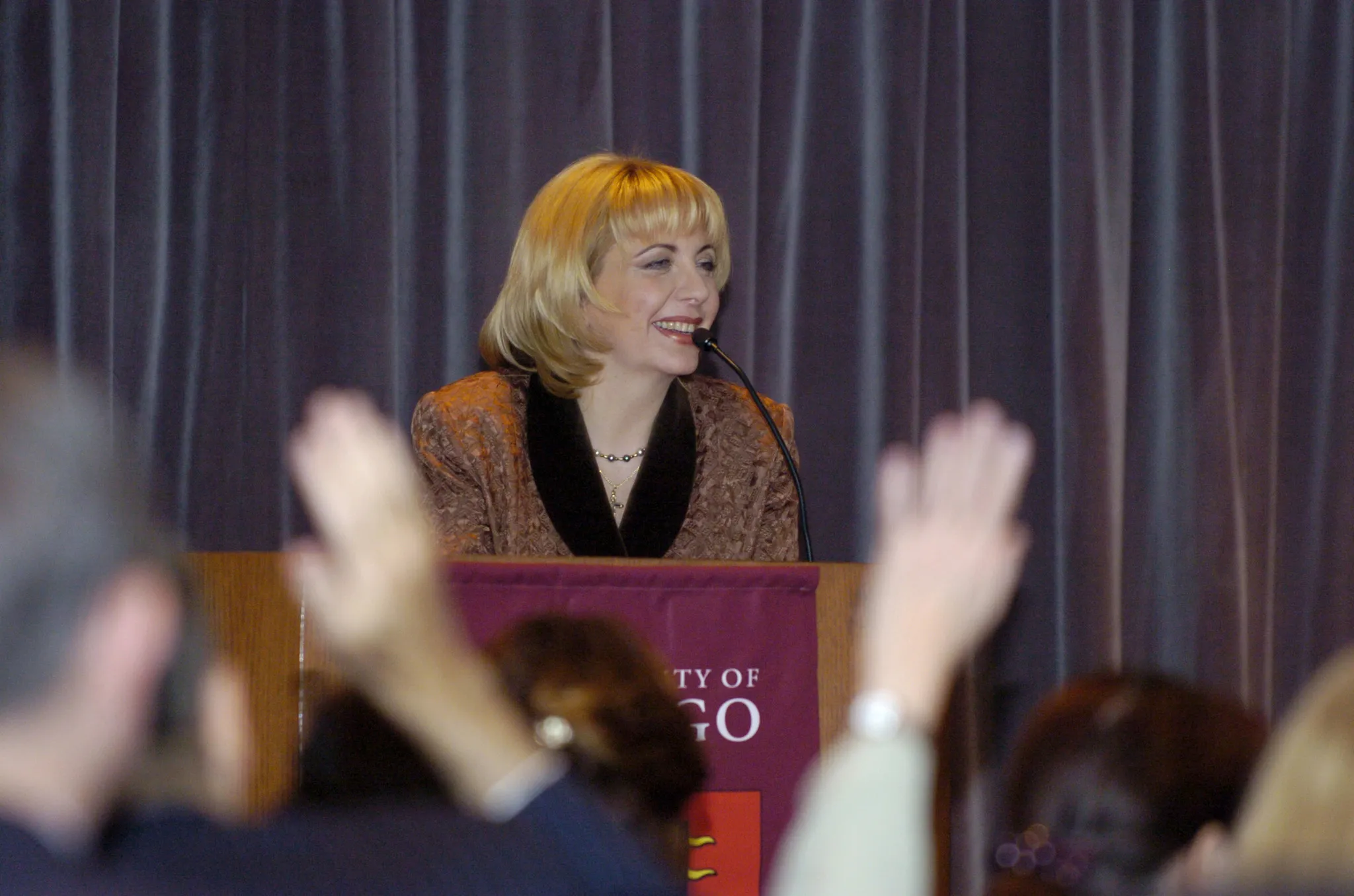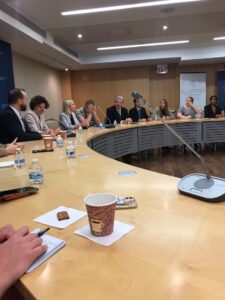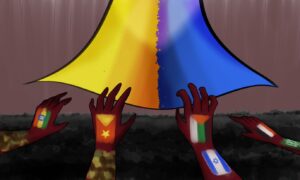Following the “mysterious” drone sightings that have violated the airspace of Poland, Estonia, Germany, Belgium, France, and more, leaders worldwide have been pressuring Putin into peace talks to stop his invasion of Ukraine.
Ukrainian-American politician and former First Lady of Ukraine, Kateryna Yushchenko, has been helping Ukrainians during this war by influencing foreign policy, traveling all over the world to give talks and shine a light on the horrors of the war, and urging the citizens of the world to take a stance. In my interview with her, she commented on these efforts, claiming, “If Russia stops fighting, there is no war. If Ukraine stops fighting, there is no Ukraine.”
After Zelensky met with over 50 European leaders at the European Union (EU) summit in Copenhagen on Oct. 2, many expected to see a resolute response from the Western powers. Even the threat of war to members of the EU and the North Atlantic Treaty Organization (NATO) by a nation that has a long history of invading sovereign territories does not urge the international community to take a stand. Nevertheless, the US, NATO, and Europe are all stalling.
It is a shame that this apparent agreement to fight for peace in Ukraine has yet to translate into political action. While the US debates sending long-range missiles to Ukraine and the EU argues about whether to shoot down the drones that violate their airspace, Russia uses this international indecisiveness to prolong the war.
During the Copenhagen summit, two main issues were discussed, both of which could be essential aid for Ukraine. First, the possibility of building a drone wall across the eastern flank of Europe was vehemently disputed. This would not be a physical barrier, but rather, a flank of anti-drone technology to detect and jam Russian jets and missiles before they can cause any more damage. Ukraine has been advocating for the establishment of such a deterrent since the beginning of the invasion, yet the EU stalls because they claim this is NATO’s business. Meanwhile, Mark Rutte, Secretary General of NATO, refuses to spend this money on defensive technology because it is disproportionate to the cost that Russia incurs in producing its drones.
Second, the Group 7 Nations (G7) have agreed to continue sponsoring Ukraine through mobilizing 140 billion Euros of Russia’s assets frozen in G7 banks, though EU members are concerned about the “legality” of this operation. The international lawyers in Brussels are particularly worried about this, since most of these assets now lie in Belgium. The primary responsibility of any legal action would then fall onto Brussels once Russia sues the EU for confiscating its assets in the International Criminal Court (ICC).
“Belgium is fearful that if Russia sues them, they will have to take full responsibility against Russia in international court.” Yushchenko said. “However, there are many legal barriers to Russia winning because we are not confiscating assets, we are using them as loans for Ukraine.”
The legality argument is nothing but a weak guise. What about the legality of Russia’s two unprovoked invasions of Ukraine? Or the 100,000 war crimes it has committed in Ukraine since 2014? Or its persistent targeting of Ukraine’s energy sector with the intent of cutting off civilians’ electricity supply for the winter? “Russia wants to take away our identity and our culture,” the former First Lady Yushchenko said. “They burn our history books, execute our leadership, murder anyone who speaks Ukrainian,”
As of 2024, Russia has caused around $150 billion in damages to Ukraine’s infrastructure via missile and drone strikes. Military defense each year alone costs Ukraine’s Gross Domestic Product (GDP) around $50 billion. Moreover, the war has forced 6.9 million refugees to flee Ukraine, while 3.7 million people remain internally displaced. It is impossible to guess how many people have been killed during the war, since Ukraine makes an effort to keep military statistics confidential during war; however, some estimates reach almost half a million. The full-scale invasion started almost four years ago. The destruction that Russia has inflicted upon Ukraine’s people, economy, and cultural heritage indubitably outweighs the “illegality” of supplying Russian assets as financial aid to Ukraine. Yet, political leaders are backing away, afraid to cause an “acute escalation in the war,” while Putin continues to abuse the patience of the whole world.
The U.S. is not contributing anything more on this front. In late September, following Trump’s sudden shift away from maintaining diplomatic ties with Russia, Washington declared that it would permit Ukraine to use American-produced weapons to strike into Russian territory. Reaching 1550 miles (2494 km), the Tomahawk missiles would allow Ukraine’s military to carry out offensive operations against not only Moscow but also at least 1,945 other military objects in Russia. However, when asked whether the U.S. would sell the Tomahawks to NATO for exportation to Ukraine, Trump publicly announced that he “sort of made a decision pretty much.”
An insightful take from the President of the United States.
The Tomahawk missiles, if supplied to Ukraine, would have a major impact on Ukraine’s offensive tactics. In an interview with Fox News, Keith Kellogg, a special envoy to Ukraine, emphasized that “there are no such things as sanctuaries,” meaning that Ukraine has a full right to strike back at Russia. Unfortunately, the chance that Ukraine receives these missiles is low. First, Russia is threatening to attack an air base in Poland, which serves as a military delivery hub for Ukraine, if the U.S. does send the missiles. Second, it is also due to the fact Ukraine does not possess the trained personnel or the compatible sea launch pads to deploy the Tomahawks. Russia has also made clear that the U.S.’s further involvement would ensure an end to Trump’s efforts of sustaining a diplomatic relationship with Putin.
These obstacles are just that—hurdles that can be overcome. If we have drawn any conclusions about Ukraine’s army in these past three and a half years of war, it is that we are fast learners. Soldiers can be trained, and even though Ukraine does not currently have access to a substantive naval fleet, there are variants of the Tomahawks, called the Gryphons or GLCM, that can be launched from land. If Ukraine receives a large enough supply and manages to utilize it in massive offensive tactics, this strategy could potentially force Putin to reconsider peace talks. After all, a single Tomahawk launched from Kyiv could reach Moscow in less than two hours.
Ukraine’s response to the EU’s and US’s reluctance to take a hard stance could be described as carefully optimistic.
“Ukraine can win,” Yushchenko reassured. “We are hoping that the U.S. and Europe understand that it’s not just a moral issue to support Ukraine, it’s in their geopolitical interests. The cost of not helping Ukraine and protecting democracy would be many times more expensive.”
She also emphasized that surrender is not an option.
As Yushchenko emphasized, “It’s not about the loss of territories, it’s about the people living there. No one wants peace more than Ukrainians do, but we also do not want to be destroyed by the conditions of peace. And we would rather die fighting than on our knees.”
The war will end only if the West deters Russia. President Trump and NATO know what needs to be done. Their job now is to do it.






Amazing article! Loved the precise numbers, valuable insights from the former first lady and especially emphasis on the “obstacles” that are de facto excuses for delaying or avoiding taking action entirely.
Great article, Sasha! Very comprehensive and profoundly informative!
Great article! Really appreciated the amount of effort put into research and the resoluteness of the message, as well as the emphasis that the “reasons” EU and US use for not acting are excuses more than anything.